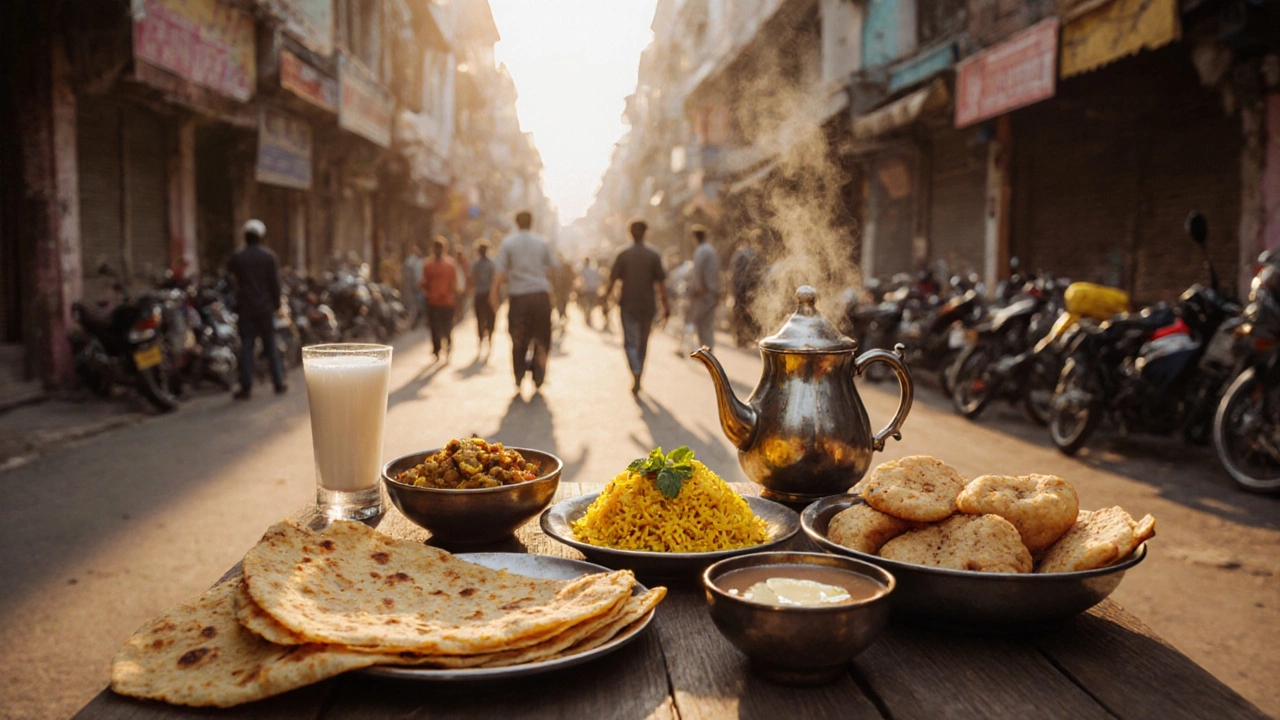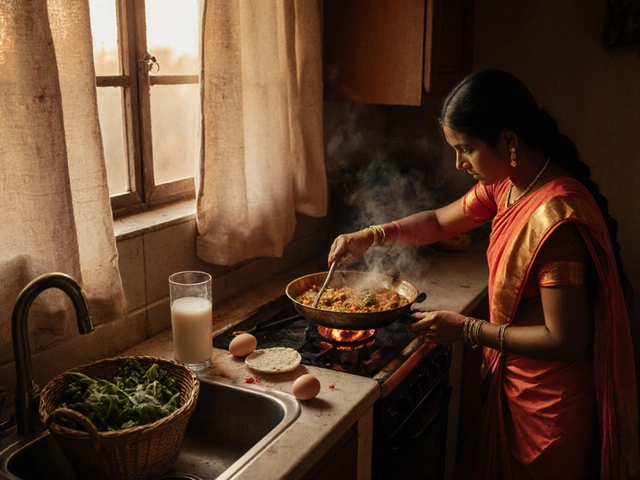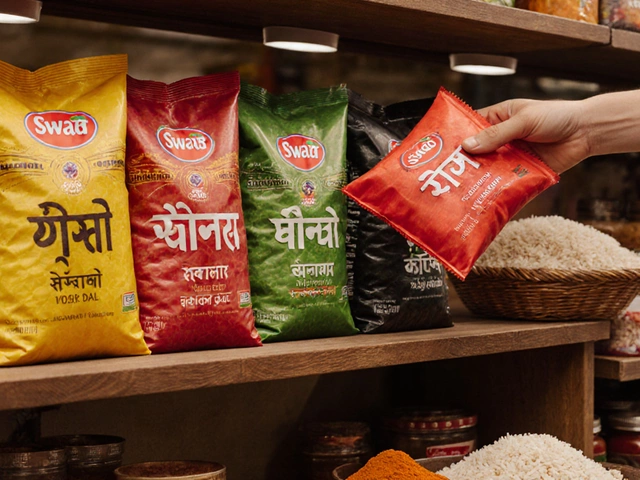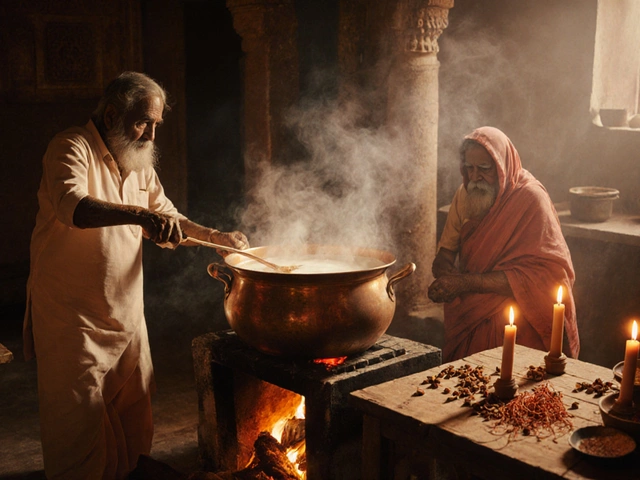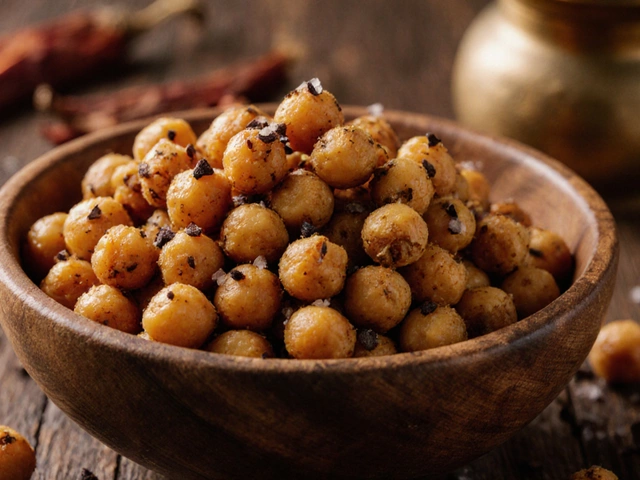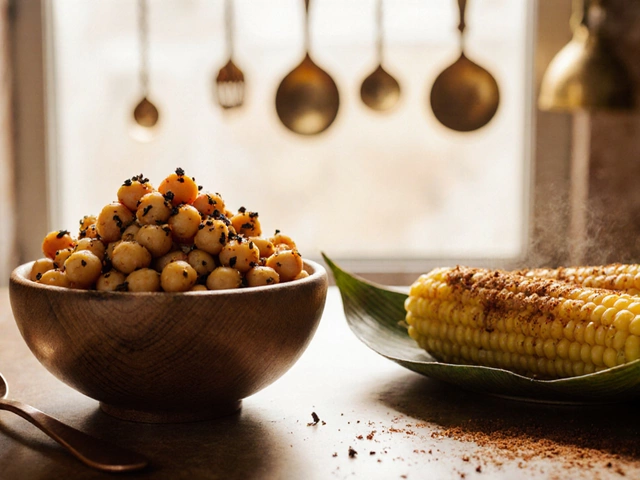When you wonder what to eat in the morning in India, the answer isn’t a single dish but a colorful spread that changes from Delhi’s bustling lanes to Kerala’s quiet backwaters. Indian breakfast covers everything from fluffy flatbreads to fermented rice cakes, each tied to local culture, climate, and daily routine. Whether you’re a traveler looking for a quick bite or a busy professional seeking a healthy start, this guide walks you through the most popular choices, the health benefits, and quick‑prep tips.
Why Breakfast Matters Across the Subcontinent
India’s climate ranges from chilly hill stations to humid coastal cities, so the morning meal serves two purposes: fuel the body and balance the weather. In the north, a hearty paratha with butter provides extra calories for cooler mornings, while in the south, a light bowl of idli with sambar offers hydration for hot, humid days. Studies by the Indian Council of Medical Research (2024) show that people who include protein‑rich breakfast items such as dal or paneer report 15% higher sustained energy levels during the first three hours of work.
North Indian Classics
- Paratha a layered whole‑wheat flatbread cooked with ghee or oil, often stuffed with potatoes, cauliflower or paneer
- Aloo Poha flattened rice tossed with mustard seeds, turmeric, green chilies and boiled potatoes
- Chole Bhature spicy chickpea curry served with deep‑fried fluffy breads
- Masala chai - strong black tea brewed with ginger, cardamom, cinnamon and milk
These dishes are typically cooked on a tawa or a deep‑fat pan, meaning they’re best when you have 20‑30 minutes before work. Pair them with a glass of Lassi a yogurt‑based drink, sweet or salty, that aids digestion for a cooling effect.
South Indian Staples
- Dosa a thin, crispy crepe made from fermented rice‑lentil batter, served with coconut chutney and sambar
- Idli steamed rice‑lentil cakes, soft and fluffy, commonly paired with the same sambar and chutney combo
- Upma a savory semolina porridge cooked with mustard seeds, curry leaves, peanuts and vegetables
- Filter coffee - strong brew mixed with hot milk and sugar, a daily ritual in Tamil Nadu and Karnataka
Because the batter ferments overnight, you can prepare a batch on Sunday and have a ready‑to‑cook breakfast all week. The cooking time for a dosa is under five minutes once the pan is hot, making it perfect for a rushed morning.
East & West Quick Picks
- Puri Bhaji deep‑fried puffed bread served with spiced potato gravy, popular in West Bengal and Gujarat
- Dhokla steamed gram‑flour cake seasoned with mustard seeds and green chilies, a Gujarati favorite
- Methi Thepla fenugreek flatbread from Gujarat, made with whole‑wheat flour and spices
- Masala chai or filter coffee, depending on the region
These items can be prepared in bulk and refrigerated, letting you grab a piece and a spoonful of bhaji in under two minutes.
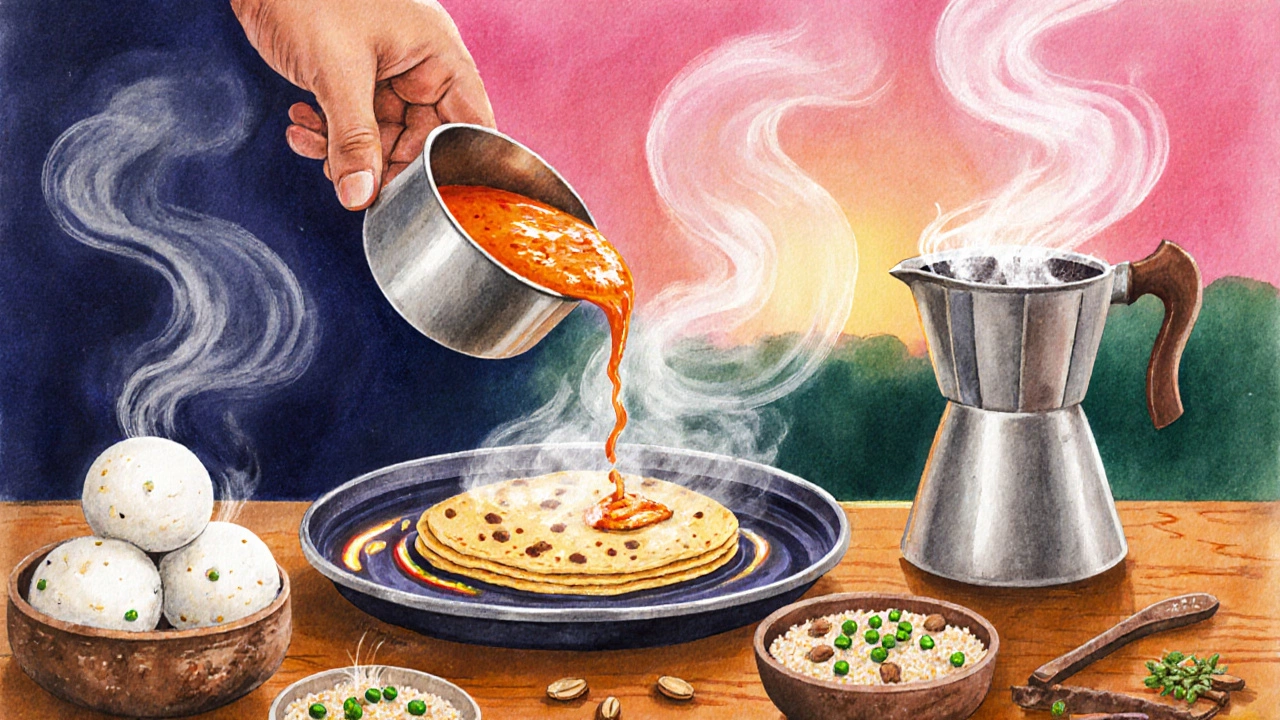
Healthy and Light Options
If you’re watching calories or need a protein boost, consider these choices:
- Moong dal chilla - savory lentil pancakes, high in protein and fiber.
- Fruit‑laden curd bowls - low‑fat yogurt with fresh mango, papaya, and a drizzle of honey.
- Sprouted moong salad - boiled sprouts tossed with onions, tomatoes, lemon juice, and a pinch of chaat masala.
- Oats upma - oats cooked like traditional upma, adding veggies for extra micronutrients.
All these dishes can be ready in 10‑15 minutes and provide sustained energy without the heaviness of deep‑fried fare.
How to Choose Based on Time & Preference
- Less than 10 minutes? Grab a pre‑made idli, dosa batter, or a bowl of fresh fruit curd.
- 20‑30 minutes available? Cook a paratha with a quick potato stuffing or whip up a poha.
- Morning at home vs. office? Pack portable items like dhokla, thepla, or oats upma in a lunchbox.
- Looking for a hearty start? Combine a protein source (paneer, dal) with a carb (paratha, bhatura).
Match the dish to your climate: choose lighter, steam‑based foods in hot coastal towns, and richer, butter‑laden breads in cooler hill stations.
Sample Breakfast Plan for a Week
| Day | Main Dish | Side | Drink |
|---|---|---|---|
| Monday | Masala Chai & Aloo Poha | Plain Yogurt | Masala Chai |
| Tuesday | Dosa | Sambar & Coconut Chutney | Filter Coffee |
| Wednesday | Moong Dal Chilla | Mint Chutney | Lassi |
| Thursday | Paratha (Paneer stuffing) | Pickled Onions | Masala Chai |
| Friday | Idli | Sambar & Tomato Chutney | Filter Coffee |
| Saturday | Puri Bhaji | Spicy Potato Curry | Lassi |
| Sunday | Oats Upma | Fresh Fruit Slices | Masala Chai |
This plan balances indulgence with nutrition, giving you a taste of north, south, east and west without repetitive meals.
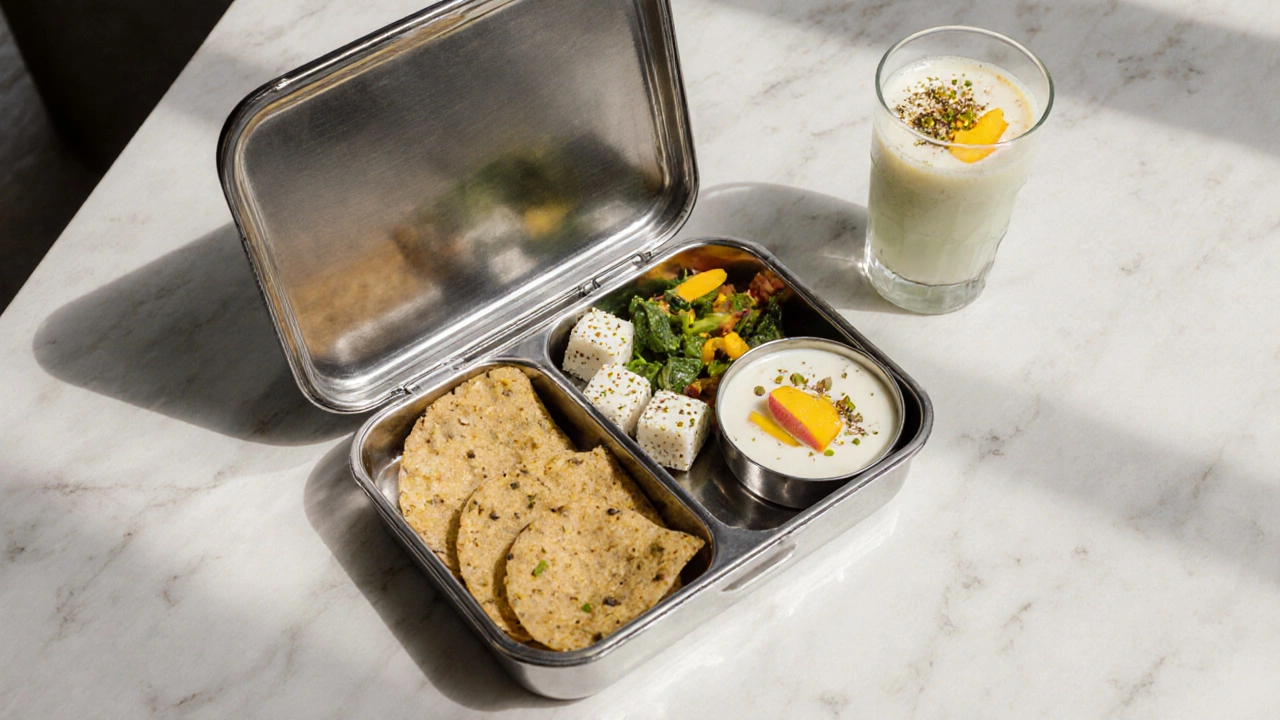
Quick Comparison: North vs South Breakfast Overview
| Region | Typical Dish | Main Ingredient | Cooking Time | Health Rating |
|---|---|---|---|---|
| North | Paratha | Whole‑wheat flour & ghee | 20‑30min | Medium |
| South | Dosa | Fermented rice‑lentil batter | 5‑7min | High |
| North | Chole Bhature | Chickpeas & deep‑fried bread | 25‑35min | Low |
| South | Idli | Steamed rice‑lentil cakes | 10‑15min (steaming) | High |
Use this table to decide whether you need a quick, low‑fat option (south) or a more filling, calorie‑dense start (north).
Putting It All Together
Now that you’ve seen the variety, the next step is simple: pick a dish that fits your schedule, climate, and taste buds, then add a side of protein or fresh fruit to round it off. Indian breakfast isn’t just about fuel-it’s a cultural experience that can set the tone for a productive day.
Frequently Asked Questions
What is the healthiest Indian breakfast?
Dishes that combine fermentation, lean protein, and vegetables rank highest. Examples include idli with sambar, moong dal chilla, and oats upma. They provide good gut flora, essential amino acids, and complex carbs without excess oil.
Can I prepare Indian breakfast ahead of time?
Absolutely. Batter for dosa or idli can ferment overnight, paratha dough can rest for a few hours, and cooked poha or upma stores well in the fridge for up to three days. Just reheat with a splash of water or oil.
What should I drink with my breakfast?
Traditional choices are masala chai, filter coffee, lassi, or plain water. If you need a protein boost, opt for a small glass of low‑fat lassi or a bowl of curd.
Is street food safe for breakfast?
Most popular street foods like samosa, kachori, and vada are safe when prepared at busy, reputable stalls with high turnover. Look for vendors who cook food fresh in front of you and keep the area clean.
How can I make a vegetarian Indian breakfast?
All the dishes listed above are vegetarian by default. Add paneer, soy chunks, or boiled eggs for extra protein if you’re not vegan.
